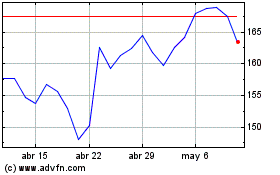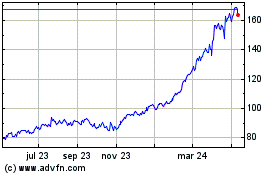GE Swings to Quarterly Profit as It Shrinks--3rd Update
30 Abril 2019 - 9:40AM
Noticias Dow Jones
By Thomas Gryta
General Electric Co. swung to a first-quarter profit and
reported stronger cash production than expected, but cautioned that
the grounding of Boeing Co.'s 737 Max airliner could hurt the
timing of its cash flows.
GE's Aviation business supplies jet engines for the Boeing
plane, which has been grounded after two fatal crashes. Boeing has
halted new MAX deliveries, which could slow the pace at which GE's
factories can ship engines for the plane.
The Aviation unit's backlog of orders has been a bright spot for
GE, which has struggled with slack demand in its other major
division, which makes turbines for power plants. In the first
quarter, sales and profits rose in Aviation while both fell at
Power.
Overall, GE's core industrial businesses burned through $1.2
billion of cash in the first quarter; the company warned earlier
this year that cash flow would drop as much as negative $2 billion
in 2019.
On a conference call Tuesday, executives said they expect
industrial cash flow to be negative in the second quarter. They
estimated the Boeing Max problems could delay roughly EUR200
million in cash flow in the second quarter. The company maintained
its forecasts for the full year.
It has called 2019 a "reset year" and said the first quarter
would be the low point of the results. New CEO Larry Culp is
restructuring the company, prioritizing the struggling Power
division as well as reducing the conglomerate's massive debt
load.
"One quarter is a data point, not a trend," Mr. Culp said on a
conference call Tuesday. He noted that most of the company's
restructuring efforts would fall into the second half of the
year.
In the first quarter, GE reported a profit of $3.55 billion,
compared with a year-ago loss of $1.18 billion. Revenue fell 2% to
$27.29 billion, as a 22% decline in the Power division offset gains
in Aviation and other units.
In the quarter, GE completed the sale of its century-old
locomotive business, struck a more than $20 billion deal to sell
its biotechnology business and paid $1.5 billion to settle a
long-running Justice Department probe into a legacy subprime
mortgage lending business.
Investors and analysts see cash production as a strong measure
of a company's performance and value. For GE, which has all but
eliminated its dividend, the goal is returning to sustainable cash
flow. But like many things at GE in recent years, the company's
complexity makes it difficult to assess performance around a single
financial metric.
GE expects to report positive cash flow in 2020, but a slide for
its conference call shows the Power division isn't expected to
produce cash until 2021.
Analysts had varying expectations for the company's performance
in the quarter. RBC Capital analyst Deane Dray estimated negative
cash flow of $4 billion and Gordon Haskett analyst John Inch
projected cash burn of $2.5 billion. JPMorgan analyst Stephen Tusa
estimated a negative $3 billion.
Adjusted quarterly earnings per share were 14 cents, ahead of an
analyst projection of 9 cents a share, according to Refinitiv,
while revenue was slightly above the consensus view of $27.05
billion.
GE shares rose about 5% to $10.24 in early trading Tuesday. The
stock has surged about 34% this year, but is down 30% in the last
12 months. Two years ago, GE shares traded at close to $30.
GE said its Power business eked out a small profit even as
revenue fell 22% from a year ago to $5.66 billion. GE has been
restructuring the unit, which has struggled with slack demand for
power plant equipment and excess inventories. GE said orders fell
14% in the latest quarter but rose in the gas side of the
business.
The division, which had been GE's biggest in terms of revenue,
has been at the center of GE's financial and operational woes. The
company recorded a $22 billion accounting charge last year mostly
related to its acquisition of Alstom SA's power business in
2015.
The Aviation unit, which make jet engines used by Boeing and
Airbus, reported $1.66 billion in quarterly profit as revenue rose
12% to nearly $8 billion, making it GE's biggest and most
profitable unit. The business shipped more than 400 LEAP engines in
the quarter, more than twice as many as in last year's quarter.
GE's CFM joint venture with Safran SA makes engines for the 737
MAX and Safran recently warned of cash flow delays related to the
plane's troubles.
The Healthcare unit had a quarterly profit of $781 million on
flat revenue of $4.68 billion. GE is selling off the fast-growing
biotech side of the operations, using the proceeds to help pay down
debt. That will leave behind a business focused on selling hospital
equipment such as MRI machines.
GE Capital ended the first quarter with $122 billion of assets.
GE has been shrinking the once massive lending operation, which
still includes a large jet leasing business and legacy insurance
business. The unit had a profit of $135 million from continuing
operations in the quarter and GE has said it would have to pump $4
billion into the unit this year.
Write to Thomas Gryta at thomas.gryta@wsj.com
(END) Dow Jones Newswires
April 30, 2019 10:25 ET (14:25 GMT)
Copyright (c) 2019 Dow Jones & Company, Inc.
GE Aerospace (NYSE:GE)
Gráfica de Acción Histórica
De Mar 2024 a Abr 2024

GE Aerospace (NYSE:GE)
Gráfica de Acción Histórica
De Abr 2023 a Abr 2024
